This post will teach you how to choose a safe, non-toxic sunscreen with the optimal SPF, that protects from both UVA and UVB rays, is reef safe, and free from potentially harmful ingredients such as parabens, fragrances, phthalates and oxybenzone.
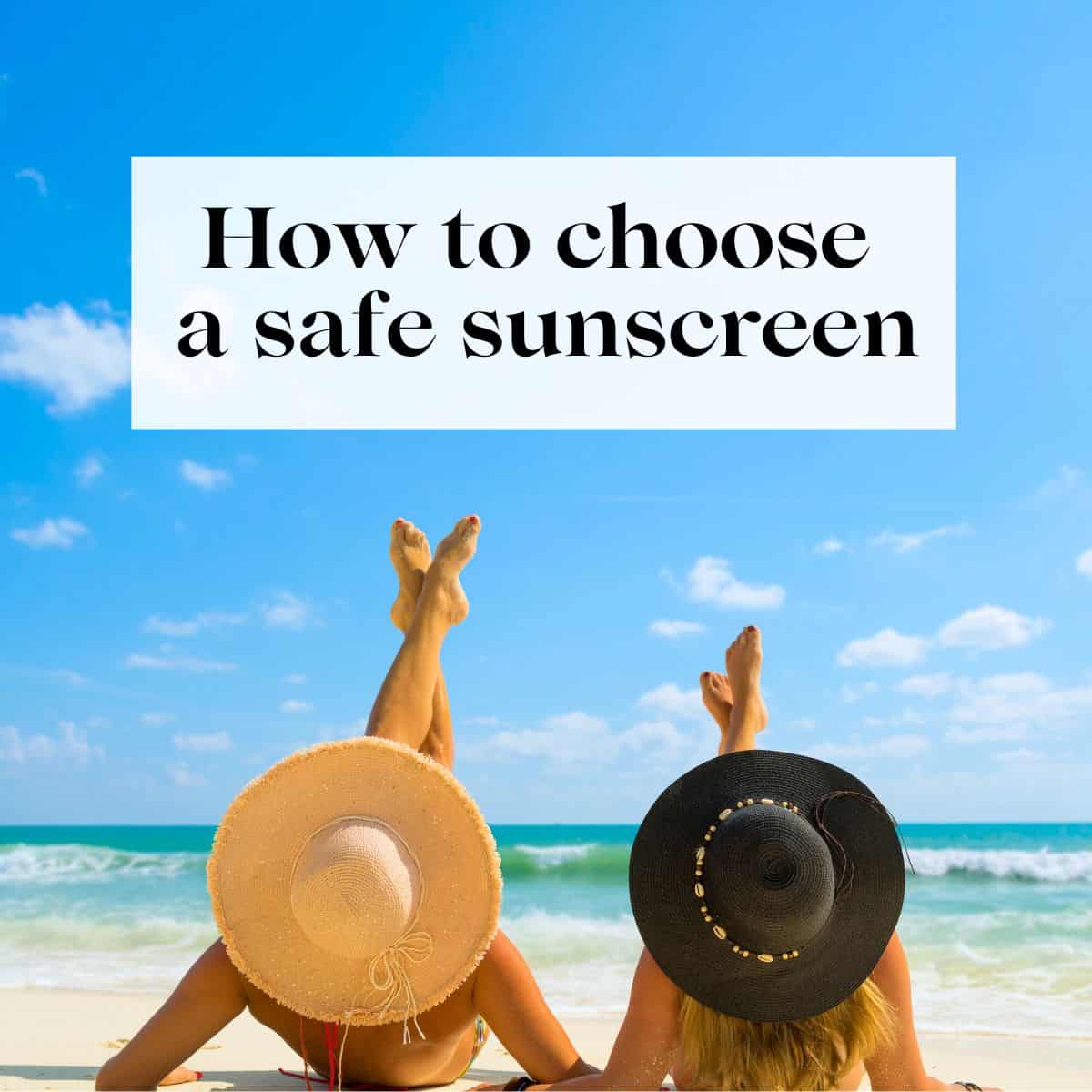
Disclaimer: some of the links in this post are affiliate link where I make a small commission if you order the product through that link. This does not cost you anything extra and helps me keep this website running.
Table of Contents
Why wearing sunscreen is important:
There is so much confusion out there regarding sunscreens. Between SPF numbers, active ingredients, mineral sunscreens vs chemical sunscreens it can be very daunting heading into the sunscreen isle and trying to choose sunscreen products.
But wearing sunscreen is important if you are going to be in the sun for any prolonged amount of time. We know that too much sun exposure can lead to premature aging of the skin, sunburns, and contribute to skin cancer, so it is important to keep yourself and your family protected by wearing sunscreen or protective clothing.
But every sunscreen is not created equal, and sunscreens can be made with ingredients that have risks to human health, so I decided it was time to put together a guide to help you choose a non-toxic sunscreen.
Tips for choosing non-toxic sunscreen:
1. Higher SPF isn't always better
This is a confusing one for many people. Most people have no idea what SPF actually means. SPF stands for sun protection factor. What SPF refers to is a sunscreen's ability to prevent UVB from damaging the skin or causing a sunburn (it doesn't indicate the product's ability to block UVA rays or its UVA protection however).
This is how it works: If it takes 20 minutes for your unprotected skin to start turning red, using an SPF 15 sunscreen means that it will take 15 times longer for your skin to turn red (about five hours). So an SPF of 30 means it takes 30 times longer to start turning red, etc.
Most people also don't know what the differences are between the different SPF values and their ability to block the suns rays. Many people assume that choosing an SPF 100 means they would get double the protection compared to an SPF 50. Unfortunately this isn't correct.
The differences in protection between SPF 25, 30, 50 and 100 are extremely small. An SPF of of 25 blocks 96% of the UVB rays, an SPF 30 blocks 97%, SPF 50 98%, and SPF 100 99%. No sunscreen can block 100% of the suns rays.
So by choosing an SPF 100 over an SPF of 30, you really aren't getting that much in addition protection from the sun (only 2%). People often get a false sense of security by choosing very high SPF sunscreens, but what you are often getting by choosing SPF values higher than 30 is exposure to more potentially harmful ingredients (keep reading for details on these ingredients).
Higher SPF products require higher concentrations of sun-filtering chemicals than lower SPF sunscreens. Unfortunately, many of these sun-filtering chemicals are not good for our health, being known to cause tissue damage and hormone disruption. They can also cause allergic skin reactions.
There is also no evidence that SPF's above 60 are any better at reducing skin damage and skin cancer risk compared to SPF values of 60 or lower. That is why the FDA has proposed that moving forward higher SPF sunscreens simply be labelled as SPF 60+.
In other words, choosing sunscreen with SPF's between 30-60 (as long as you use them properly) should optimize your protection from both UVA and UVB rays, offer great sunburn protection, and limit your exposure to additional harmful chemicals that are required to make higher SPF rated sunscreens.
2. Use mineral sunscreens, not chemical sunscreens
The active ingredients (the ones that protect you from burning) in sunscreens come in two forms: mineral and chemical filters. Each uses a different mechanism for protecting skin and maintaining stability in sunlight. Most of the common sunscreens on the market (think brands like Coppertone, Neutrogena, Banana Boat etc) are made with chemical filters.
The individual chemical sunscreen filters actually don't work that well when it comes to protecting skin from the sun. Because of this, they are often combined to help increase their effectiveness, so many of these sunscreens contain a combination of two to six of these chemical filters which come in the form of oxybenzone, avobenzone, octisalate, octocrylene, homosalate and octinoxate.
Besides offering inferior protection from the sun, another problem with the chemical filters is that some of them can be bad for our health. Some of the chemical filters can act as hormone disruptors, and they can also cause allergic reactions.
And for breast feeding women, oxybenzone and other chemical filters can end up in your breast milk. And besides the health related concerns, oxybenzone is also bad for the environment and is destroying the coral reefs.
In contrast, mineral sunscreen ingredients don't penetrate the skin like chemical sunscreen ingredients do, meaning that they can't impact your internal organs or hormones like chemical barriers can, and are therefore are a healthier and safer option. Mineral sunscreens work by sitting on top of the surface of the skin, acting as a physical barrier to protect your skin from the sun's uv radiation. For this reason they are often referred to as physical sunscreens.
Because of the concerns related to chemical sunscreen ingredients, the most recent Food and Drug Administration (FDA) recommendations are that only zinc oxide and titanium dioxide can be recommended as generally safe and effective (GRASE) when it comes to sunscreens and that chemical sunscreen ingredients cannot be recommended as safe and effective.
When it comes to mineral sunscreen filters I suggest using zinc oxide based sunscreens if possible as it is known that zinc oxide is more effective than titanium dioxide. You also want to be sure to choose brands that are using non-nano zinc oxide. Nano particles can be harmful to our health and are easily inhaled so you want to be sure to avoid them.
The good news is that mineral sunscreens are becoming increasingly popular so it's much easier to find them now than it was even a few years ago.
3. Avoid fragrances
Fragrances are considered to be trade secrets. This means that companies don't have to tell you what ingredients they are using to make their fragrances.
The problem with this is that fragrances can be made with many different ingredients, including chemicals known to cause endocrine disruption (including phthalates and parabens). Because of this I recommend avoiding any sunscreens with the words "fragrance", "perfume" or "parfum" in the ingredient list.
4. Avoid phthalates
Phthalates are a group of plasticizing chemicals that allow products to become more pliable, and fragrances to stick to your skin and last longer. The three phthalates most commonly used in personal care products are diethyl phthalate (DEP), which is found in scented products, and di-n-butyl phthalate (DnBP) and di-isobutyl phthalate (DiBP), which are used in nail polish and cosmetics.
Phthalates are found in most items that contain fragrance and can also be a part of the company’s “secret formulas” so that they don't have to be disclosed on the label. Studies done in the lab and on animals show that DEP, DnBP and DiBP have estrogen-like properties and anti-androgenic properties (androgens are the male type hormones found in the body). In other words, they disrupt your hormones and can cause hormone imbalances. They have also been linked to birth defects and infertility.
5. Avoid parabens
Parabens are used as preservatives, anti-bacterial agents and stabilizers in many skin care and cosmetic products. The parabens used most often in personal care products are methyl, ethyl, butyl and propyl paraben. Parabens have weak estrogenic and anti-androgenic activity and can be hormone disruptors or endocrine disruptors. Parabens have been linked to breast cancer, skin cancer, decreased sperm counts and infertility.
When you are reading labels, look for ingredients ending in "aben" as this will indicate a paraben.
6. Avoid benzene
Thousands of sunscreens have been recalled over the last few years due to their contamination with benzene. These include both chemical and mineral sunscreens, and many from popular brands including but not limited to Neutrogena, Sun Bum, Raw Elements, Banana Boat, EltaMD, Babyganics, Coppertone, Walgreens, Ethical Zinc, Max Block, La Roche Posay, Aveeno and more.
Benzene is a known carcinogen and can also cause other health issues such as aplastic anemia, so it really should not be in our sunscreen (or any other products for that matter). Be sure to keep an eye on the FDA and Health Canada recall lists to keep up-to-date on the latest sunscreen recalls related to benzene.
The best non-toxic sunscreen:
This is our favourite safe sunscreen that is not only safe and made with healthy ingredients, but it also works well and is reef safe and safe for marine life too.
Beautycounter sunscreen
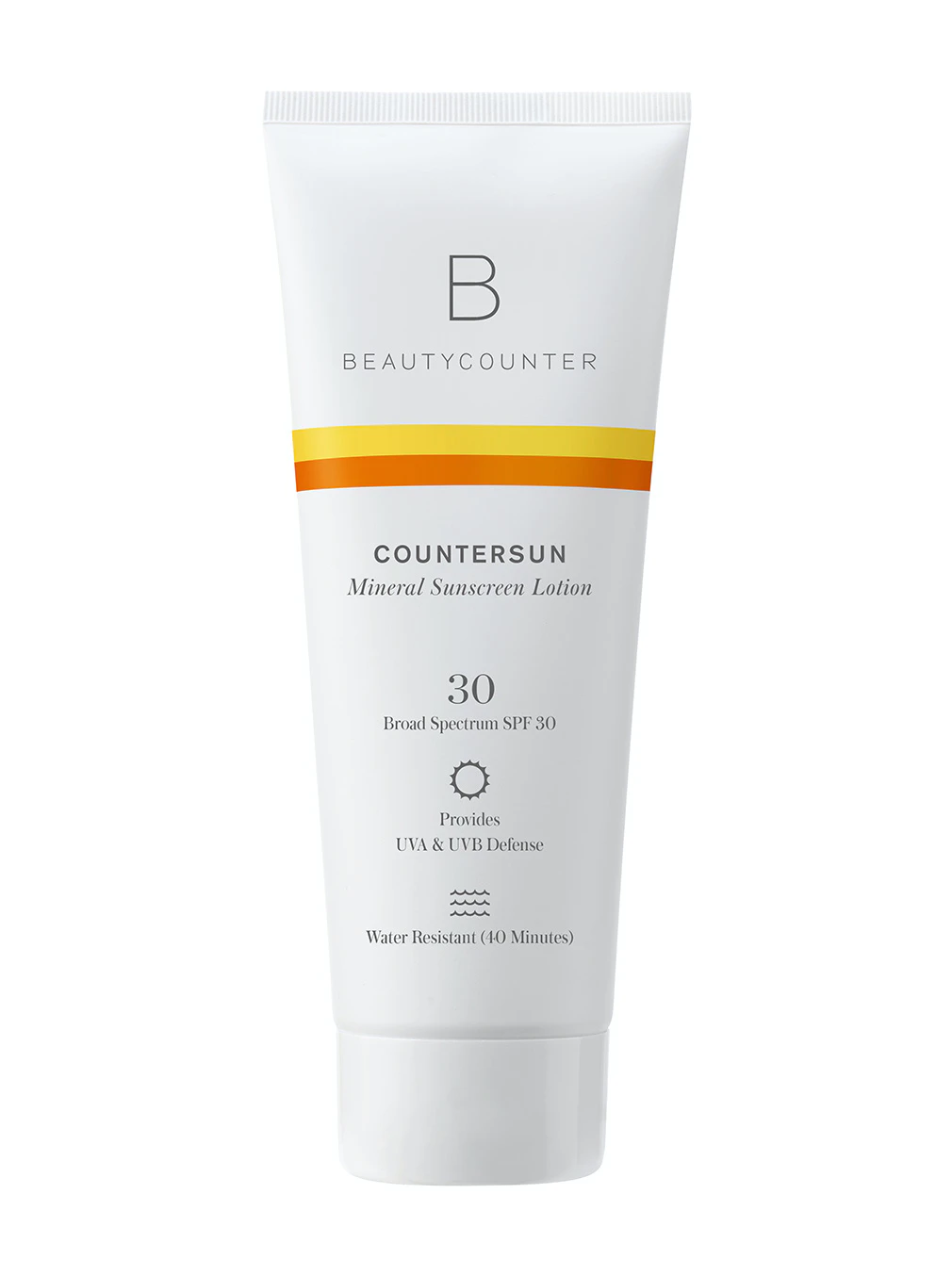
My personal favourite sunscreen, and the best sunscreen I have tried, is Beautycounter's Countersun Mineral Sunscreen. It ranks really well on the Environmental Working Group (EWG) database, in an effective sunscreen, is a broad-spectrum sunscreen (offers both UVA protection and UVB protection), is water resistant, and unlike other zinc oxide based sunscreens, it goes on nice and clear with no white cast. No thick, pasty white, thick as cement texture, like many other brands have. It's also a great option for children.
This mineral sunscreen of physical sunscreen is also great for sensitive skin and blocks blue light which most other brands do not. I use the Countersun Mineral Lotion for my body and the Sheer Defense Face Sunscreen for my face.
And if you are looking for even more safe, non-toxic sunscreen options be sure to read my full review, the best non-toxic sunscreens.
If you are wondering what ingredients you should be avoiding in skincare products and personal care products, I have a free guide which you can download below:
Frequently asked questions:
To find a safe, non-toxic sunscreen you want to find a mineral sunscreen that is broad spectrum, reef safe, SPF of 30, and free from potentially harmful ingredients such as fragrances, phthalates, oxybenzone and parabens.
Other information you will like:
- Is there mercury in your mascara
- The best non toxic body lotions
- The best non toxic body washes
- The best non toxic mascaras
- The best non toxic laundry detergents
Our expertise:
Dr. Erin Carter, MD, FRCPC, is a physician with board certifications in internal medicine and rheumatology. She is passionate about nutrition, environmental health and low toxicity living and has been doing research and publishing information in this area for years. She is also a self-trained chef and has been creating and publishing recipes since 2015. Her recipes have been featured on many different websites and online publications.

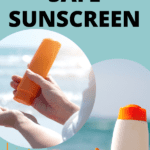
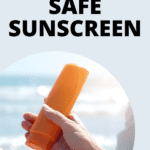
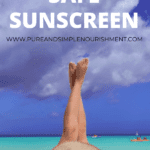



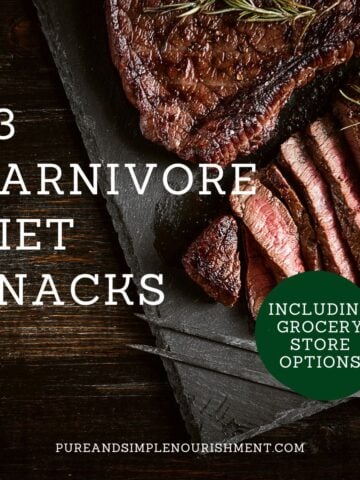
Leave a Reply